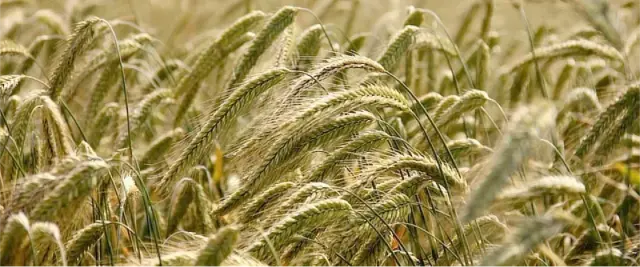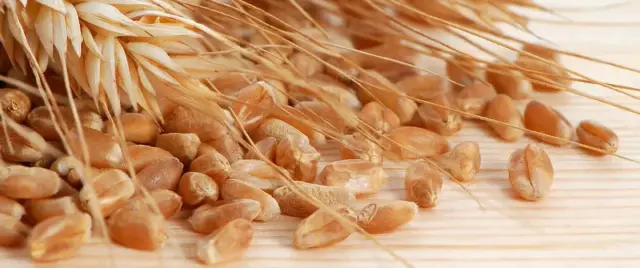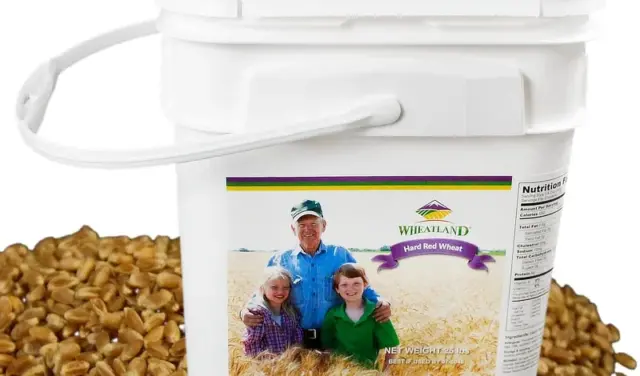Soft Wheat Berries versus Hard

Wheat is the most common grain consumed in the United States. It’s also a common ‘staple’ food that will store well for many decades under the right conditions (easy to do). There are a few different varieties, and you might wonder the difference is between them. For example, soft wheat berries vs hard wheat berries.. Or red wheat berries vs white..
Wheat (in the form of wheat berries, prior to being milled into flour) is one of the primary dry foods often kept by the preparedness-minded (e.g. preppers) for “just in case”.
One reason that wheat is an ideal choice for food storage is because wheat has a very long shelf life when stored properly (decades). The ‘goodness’ (nutrition) remains locked up in the wheat (wheat berries) awaiting the day that you mill it (grind it into flour).

Wheat is a type of grass that produces ears of grains—rows upon rows of seeds wrapped in papery husks (the chaff). The husks are stripped, leaving the kernels or berries, in order to render them edible.

There’s more than one kind of wheat. You may have heard some of the name variations – varieties. Here’s an explanation:
Hard Wheat Berries versus Soft Wheat Berries
Hardness. In short, the primary difference between them is hard wheat has more protein, and thus more capacity for gluten development.
Hard wheat has up to twice as much protein content (11-15%) than soft wheat (5-9%).
Milled flour from hard wheat is more suitable for making bread (because of the gluten), whereas flour from soft wheat berries is better for delicate pastries, cakes, pie crusts, muffins, and cookies.
Though with that said, they are both interchangeable with the caveats just mentioned.
Here’s more:
Hard Wheat Berries
The kernels of Hard wheat are hard. The Hard wheat kernel is also smaller than that of Soft wheat.
Hard wheat has higher protein (gluten is a protein). Gluten helps dough to rise as it traps the fermentation gases that result from adding yeast. The gluten is able to trap the carbon dioxide bubbles formed by the fermentation of the yeasts, causing the dough to rise. This makes it better for breads baked with added yeast.
Texture difference.. Flour ground from hard wheat berries has a granular feel, whereas flour from soft wheat has more of a powdery texture. There is not a noticeable difference in taste between the two.
Soft Wheat Wheat Berries
The kernels of Soft wheat are (you guessed it…), soft. The soft wheat kernels are also larger than hard wheat kernels.
The Soft wheat variety has less gluten content. It’s not quite as good at rising a loaf of bread. However, it is preferably used in pastries, pastas, and cereals.
“Doughs made with soft flour are flakier and crumblier and cannot retain much moisture or leaven well – the gluten web is not strong enough to trap the carbon dioxide bubbles. Bread made with soft flour is not as soft and dries out sooner.” quoted from a comment on Quora.
Tip: You can add our own gluten while making / baking your own bread. This is also high in protein.
Vital Wheat Gluten
(Anthony’s on amzn)

But wait, there’s more..
Spring Wheat versus Winter Wheat
Winter wheat is planted in the fall. It grows over winter and is harvested the following summer.
Spring wheat is planted in the spring. It grows in the summer, and is harvested in the fall.
Red Wheat versus White Wheat
Most of the Hard wheat varieties are Red wheat.
Most of the Soft wheat varieties are White wheat.
Having said that, there is a Hard White variety of wheat too. It is a compromise widely chosen for making bread because of the opinion that it tastes a bit better than bread made strictly from Hard Red wheat.
The Most Common Wheat Berries For Long Term Storage
Hard Red Wheat
The most common variety of wheat found in prepper’s wheat food storage are Hard Red Wheat Berries (spring or winter).
I believe that it’s popular for two reasons.
- It has a higher protein content, which is an important attribute when it comes to meeting protein consumption goals.
- It is better for making bread.
My own inventory of wheat berries include both Hard Red Wheat (the majority) as well as Hard White Wheat. Most of what I have, I’ve packaged myself (Mylar bags with O2 absorbers, all within 5-gallon buckets).
However, I’ve found that you can find professionally packaged wheat berries that are reasonably priced too – once you factor in DIY costs (Mylar bags, 02 absorbers, buckets, lids, labor, and of course the wheat berries).
Here’s some grown in Utah and Idaho, sourced directly from family farmers. No additives, Non GMO.
25 Pound Pail
(WHEATLAND on amzn)

Shelf Life – How Long Do Wheat Berries Last
The manufacturers of most pre-packaged pails of wheat berries say 25 year shelf life. It’s actually longer than that, assuming it’s packaged properly and stored in an ideal environment – cool & dry.
The following are a number of related articles that may be of interest:
Oxygen Absorbers For 5-Gallon Food Storage
How to Seal a Mylar Bag in a 5-gallon bucket
How Much Wheat In A 5 Gallon Bucket – Pounds, Calories, Loaves Of Bread
‘Diatomaceous Earth’ For Long Term Storage Of Wheat Berries, Grain, In 5-Gallon Buckets
